- / -
EMSC3025/6025: Remote Sensing of Water Resources
Dr. Sia Ghelichkhan
- / -

Groundwater — Principles
EMSC3025/6025
Dr. Sia Ghelichkhan
Objectives
By the end of this lecture, you should be able to:
- Understand the theory of saturated groundwater flow.
- Derive and apply the basic groundwater flow equation.
- Use flow nets to estimate hydraulic head distribution and flow paths.
- Identify boundary and initial conditions for analytical solutions.
- Solve simple steady-state flow problems using analytical methods.
A refresher on some basic math
Understanding Differential Equations in Groundwater
Many students find the quantitative aspects of groundwater hydrology challenging at first glance. 😱
A differential equation like this immediately suggests advanced mathematical concepts:
Good news: At this introductory level, we don’t need to solve these equations—just recognise and understand them.
Key Point
Hydrogeology provides simplified approaches for dealing with these equations.
Recognising Equation Features
You don’t need to be a math person for dealing with groundwater equations.Even as toddlers, we could recognise a rhinoceros by its features:
- Four stubby legs
- Two horns on an ugly-looking head
Similarly, differential equations have recognizable features that tell us what we’re dealing with.
The unknown we’re trying to find is usually hidden in derivative terms like:
where
What Makes an Equation What It Is?
The unknown variable determines the equation type:
- h (hydraulic head) → groundwater flow equation
- C (concentration) → mass transport equation
- T (temperature) → energy transport equation
The “stuff” on the right-hand side are functions of time and space variables (t, x, y, z) and various parameters.
Determining Problem Characteristics
Step 1: Identify the unknown
- What variable are we solving for?
Step 2: Count space dimensions
- How many spatial directions does flow occur in?
Step 3: Check for time dependence
- Does the solution change with time?
Example Analysis:
- Unknown:
h → groundwater flow - Dimensions: Only
x → 1D problem - Time: No
\frac{\partial h}{\partial t} → steady-state - Parameters: None → simple case
Problem Dimensionality
Dimensionality describes how many directions the unknown (hydraulic head) changes.
- 1D: Head changes in one direction only
- 2D: Head changes in two directions
- 3D: Head changes in three directions
Important: This refers to how many spatial variables appear in the equation, not the physical geometry.
Example
A 3D aquifer between two rivers might still have 1D flow if water only moves in the x-direction.
Steady-State vs. Transient
Steady-State:
- No time term:
\frac{\partial h}{\partial t} = 0 - Hydraulic head doesn’t change with time
- Easier to solve
Transient:
- Time term present:
\frac{\partial h}{\partial t} \neq 0 - Hydraulic head changes with time
- More complex solutions
Practice Question
Look at your flow equation. Is there a
- Yes → Transient problem
- No → Steady-state problem
Parameter Dependencies
Sometimes equations contain parameters like K, T, or S.
- If parameters are constant everywhere → hydraulic head distribution is independent of parameter values
- If parameters vary in space → hydraulic head depends on parameter values
Practical impact: You can solve for the pattern of flow, then scale it based on actual parameter values.
Differential Equations of Groundwater Flow
What sets hydrogeology apart is its emphasis on mathematical treatment of physical processes.
The goal: determine how hydraulic head varies throughout a domain.
Three Essential Components:
- Governing equation – describes groundwater flow
- Domain – geometry and layering
- Boundary conditions – head or flux at boundaries
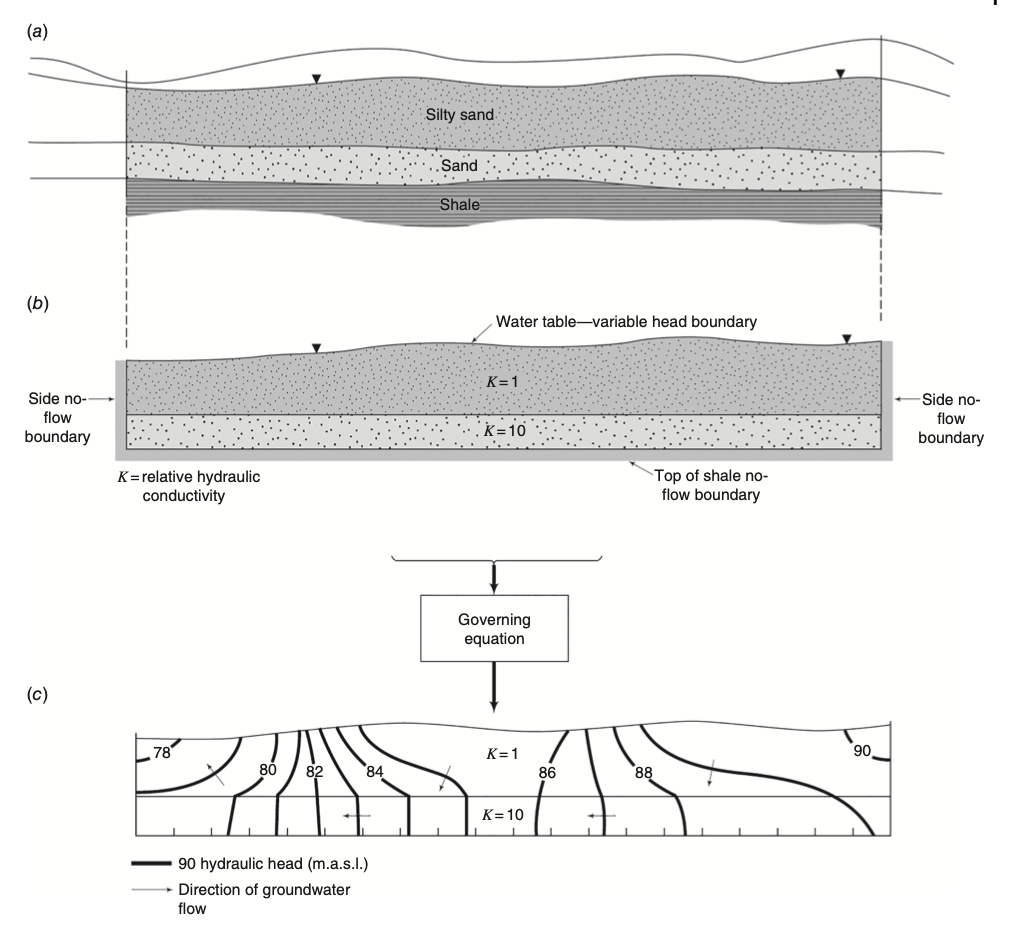
What Do We Get From Solving the Equation?
Once we solve for the hydraulic head distribution, we can:
- Draw equipotentials (contours of equal head)
- Deduce flow paths (direction of groundwater movement)
- Calculate flow rates between different points
- Predict impacts of pumping or recharge

Flow Domain vs. Flow Equation Dimensionality
Important Distinction:
The dimensionality of the flow domain ≠ dimensionality of the flow equation
- A 1D equation can describe flow in a 3D domain if flow occurs in one direction only
- The actual direction of water movement determines equation dimensionality
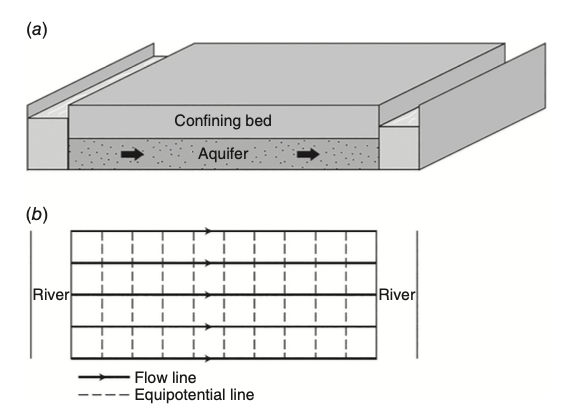
Example: 1D Flow in 3D Domain
Case Study: Aquifer Between Two Rivers
- Physical structure: 3D confined aquifer
- Flow direction: Only in x-direction (river to river)
- Governing equation: 1D flow equation
- Why? No head variation in y or z directions
Key Insight:
Look at the flow pattern, not the aquifer geometry, to determine equation dimensionality.
Deriving Groundwater Flow Equations
Starting Point: Conservation of Mass
Groundwater flow equations come from mass conservation applied to a representative elementary volume (REV).
Think of a small cube of aquifer material — water flows in and out through all six faces.
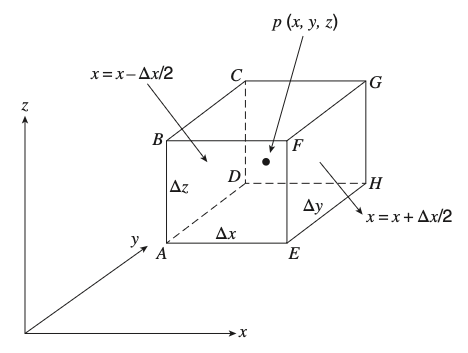
The Conservation Principle
What we account for:
- Flow through all six faces of the REV
- Water density (
\rho_w ) - Porosity (
n ) - Velocity components in x, y, z directions
Physical meaning:
- If more water flows in than out → head rises
- If more water flows out than in → head drops
- If inflow = outflow → steady-state
Mathematical Representation of Conservation
Breaking down the equation:
M_{x1}, M_{x2} = mass flow in x-direction (in and out)M_{y1}, M_{y2} = mass flow in y-direction (in and out)M_{z1}, M_{z2} = mass flow in z-direction (in and out)- Right side = rate of mass accumulation in the REV

Translation: Net mass inflow = rate of mass accumulation
Mass Flux Derivation: Step-by-Step
X-Direction Flow
Consider flow entering and leaving the REV in the x-direction:
Inflow at left face:
Outflow at right face:
Key Concept:
Flow varies across the REV due to spatial gradients. We use Taylor expansion around the center point.
Net Flow in X-Direction
Net x-direction inflow:
Same logic applies to y and
and to z direction:
Combining All Directions: Full Conservation
This equation combines:
- Net inflow from all three directions (left side)
- Rate of mass accumulation (right side)
Next step: Simplify by assuming water density is constant
Physical meaning:
Divergence of flow = storage change
Assuming Constant Water Density
Why this assumption? For most groundwater problems, water density changes are negligible compared to flow effects.
Introducing Specific Storage
The right-hand side can be simplified using specific storage (
Definition:
Remember:
Conservation in Terms of Hydraulic Head
We’re almost there! Next step: substitute Darcy’s law to express everything in terms of hydraulic head.
Applying Darcy’s Law
Darcy’s Law in 3D:
q_x = -K_x \frac{\partial h}{\partial x} q_y = -K_y \frac{\partial h}{\partial y} q_z = -K_z \frac{\partial h}{\partial z}
Substituting into our conservation equation…
Key insight:
Darcy’s law relates flow to head gradients using hydraulic conductivity.
The Final Groundwater Flow Equation
This is the fundamental equation for flow in saturated porous media!
What it describes:
- How hydraulic head (
h ) varies in space and time - 3D flow in heterogeneous, anisotropic media
Parameters needed:
K_x, K_y, K_z = hydraulic conductivityS_s = specific storage- Boundary and initial conditions
Special Case 1: Steady-State Flow
When
Physical meaning:
- System has reached equilibrium
- Inflow = outflow everywhere
- Head pattern is time-invariant
- Much easier to solve than transient problems
Example situations:
- Long-term pumping
- Seasonal averages
- Regional flow systems
Special Case 2: Isotropic, Homogeneous Media
When
This is Laplace’s equation!
- Classic partial differential equation
- Many analytical solutions available
- Foundation for flow net analysis
- Widely used in mathematical physics
Simplification:
When properties are uniform, the equation becomes much simpler to solve.
Working with Transmissivity
For confined aquifers, we often use transmissivity:
T_x = K_x \times b (transmissivity in x-direction)S = S_s \times b (storativity)b = aquifer thickness
Why transmissivity?
For confined aquifers, flow is integrated over the thickness, making T more practical.
Including Sources and Sinks
Real systems have sources and sinks:
- Wells (pumping or injection)
- Recharge from precipitation
- Leakage to/from other layers
Adding source term
Sign convention:
Q > 0 = source (injection)Q < 0 = sink (pumping)
Special Case 3: Unconfined Aquifers
Dupuit’s Assumption
For unconfined aquifers, we make a simplifying assumption:
Dupuit approximation: Vertical flow is negligible compared to horizontal flow.
- Streamlines are horizontal
- Hydraulic gradient equals water table slope
- Valid when horizontal distances >> aquifer thickness
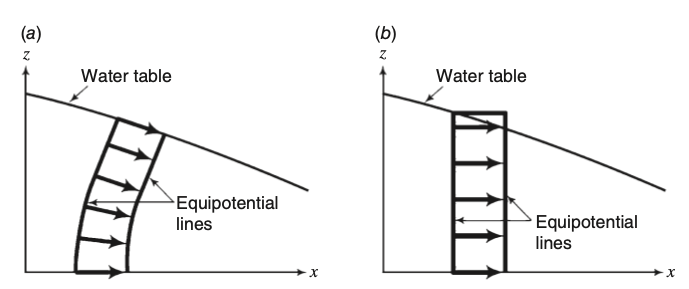
Boussinesq’s Equation
Under Dupuit approximation:
Key features:
h appears both inside and outside derivativesS_y = specific yield (not specific storage)- Commonly used for water table aquifers
Note:
This is Boussinesq’s equation - the standard for unconfined flow analysis.
Solving the Groundwater Flow Equation
The Missing Piece: Boundary Conditions
The flow equation alone is not enough!
To get a unique solution, we must specify boundary conditions - they define how our domain interacts with the surroundings.
Three main types:
- Dirichlet - specify head values
- Neumann - specify flow rates
- Cauchy - relate head and flow
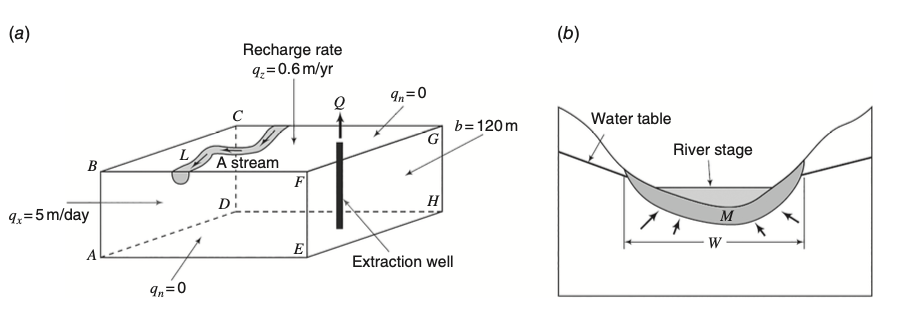 Examples of different boundary condition types
Examples of different boundary condition types
Why Boundary Conditions Matter
Without boundary conditions:
- Infinite number of possible solutions
- No way to determine actual head values
- Cannot predict real system behavior
With proper boundary conditions:
- Unique solution exists
- Realistic head distribution
- Meaningful flow predictions
Key applications:
- Rivers and lakes (known water levels)
- Recharge zones (known flux)
- Wells (extraction rates)
- No-flow boundaries (impermeable layers)
“Specified Head” Boundaries
In math we call this Dirichlet Boundary Conditions
What it specifies: Hydraulic head values directly
Common examples:
- Large lakes or rivers
- Ocean boundaries
- Artificial ponds or reservoirs
For all of these you can calculate the pressure.
When to use:
When you know the water level at a boundary and it’s much larger than your study area.
Type 2: Neumann Boundary Conditions
“Specified Flux” Boundaries
What it specifies: Water flux (flow rate) across the boundary
Common examples:
- Precipitation recharge (
q_n > 0 ) - Pumping wells (
q_n < 0 ) - Impermeable boundaries (
q_n = 0 )
Remeber
Special case:
Understanding Flux Units
Flux can be expressed two ways:
- Darcy velocity
q_n [L/T]- Flow per unit area
- This is the source term we use the flow equation
- Volumetric flow rate
Q_n [$ L^3/T $]- Total volume per time
- Used for wells and boundaries
Relationship:
“Head-Dependent Flux” Boundaries (Cauchy)
Sometimes the amount of flux in or out of the system is depending ont he solution itself.
What it specifies: Relationship between flux and head difference
Parameters:
K_m = hydraulic conductivity of boundary layerM = thickness of boundary layerh_m = external head (e.g., river stage)
Key feature:
Flux depends on head difference — more realistic for many situations.
When to Use Cauchy Boundaries
Ideal for river-aquifer interactions:
- River stage varies with time (
h_m changes) - Riverbed acts as semi-permeable layer
- Flow direction can reverse (gaining vs. losing stream)
Advantages:
- More physically realistic
- Automatically handles flow reversals
- Accounts for resistance of boundary layer
Example:
During floods,
Choosing the Right Boundary Condition
Decision Matrix:
Dirichlet
- Large water bodies
- Known, stable water levels
- Simple to implement
Neumann
- Known recharge rates
- Impermeable boundaries
- Well pumping/injection
Cauchy
- River-aquifer exchange
- Variable external conditions
- Semi-permeable boundaries
The choice depends on: physical setting, available data, and modeling objectives.
Initial Conditions: Starting Point for Transient Problems
For transient (time-dependent) problems, we need to specify where we start:
What this means: At time zero, the hydraulic head at every point in the domain must be known.
Important:
Steady-state problems don’t need initial conditions — they find the equilibrium directly.
Why Initial Conditions Matter
Examples of initial conditions:
- Aquifer at natural equilibrium before pumping
- Known water table elevation from well measurements
- Results from previous model run
Physical meaning: The system’s “starting configuration” before any changes occur.
Practical tip:
Often use steady-state solution as initial condition for transient problems.
Flow-net Analysis
Constructing the streamlines or the flowlines
Visualising Groundwater Flow
From Equations to Pictures
We can visualise the results using flow nets:
Two key components:
- Streamlines (flow paths): show direction of water movement
- Equipotential lines: contours of equal hydraulic head
Key property: In isotropic, homogeneous media, streamlines and equipotentials intersect at right angles.
Remember:
Water flows perpendicular to equipotential lines, from high head to low head.
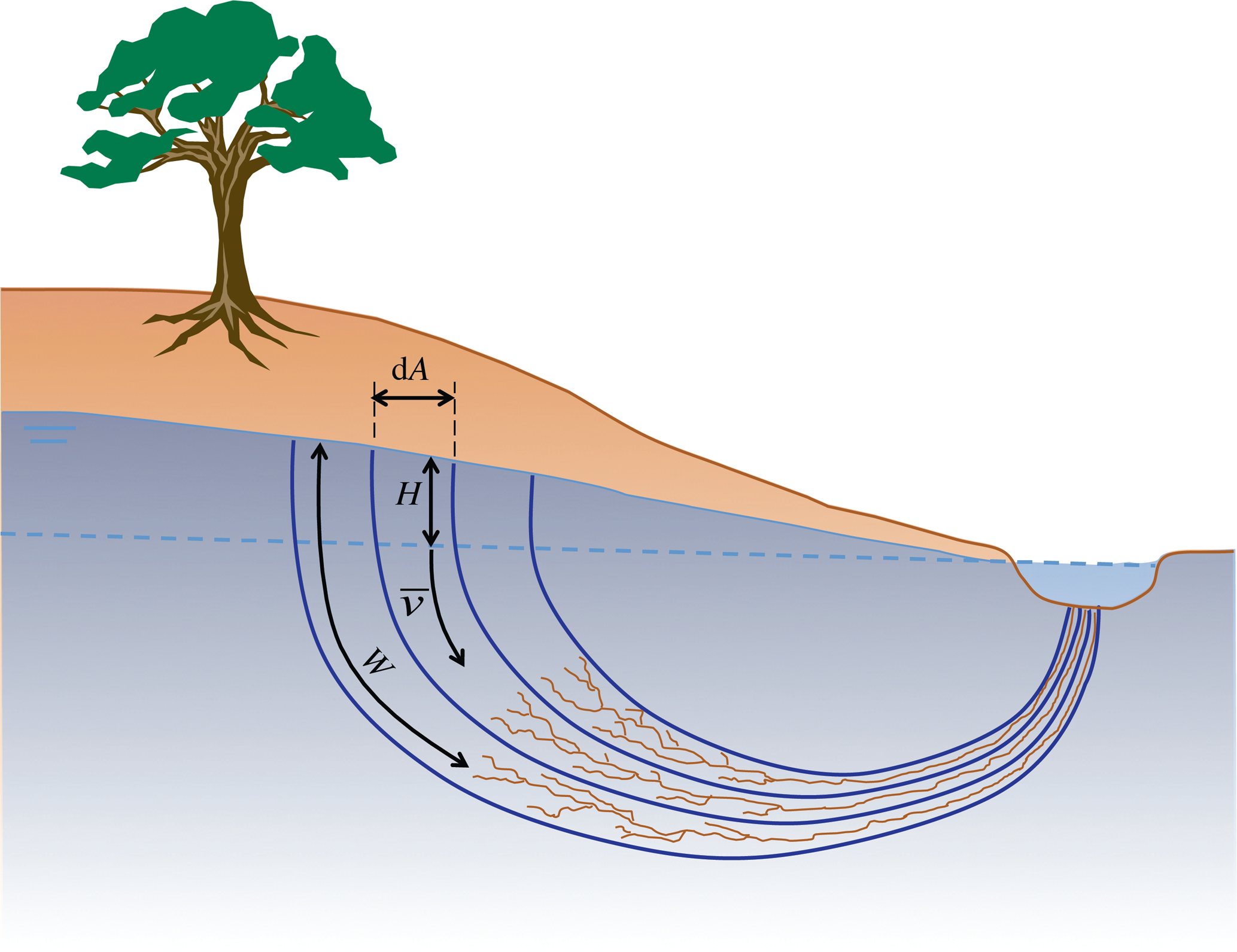
Flowlines are our way of visualising the flow, without solving the flow equation.
The Mathematical Foundation
For 2D steady-state flow in isotropic, homogeneous media:
This is Laplace’s equation - it has special mathematical properties that make flow nets possible.
Why 2D?
Many practical problems can be simplified to 2D, making flow nets a powerful tool.
Rules for Constructing Flow Nets
Geometric rules:
- Orthogonality: Equipotentials ⊥ streamlines
- Curvilinear squares: Lines form approximate squares
- Equal spacing: Same head drop between equipotentials
- Conservation: Same flow between adjacent streamlines
Boundary conditions:
- No-flow boundaries → parallel to streamlines
- Constant-head boundaries → parallel to equipotentials
- Symmetry lines → can be treated as no-flow
The famous dam seepage problem
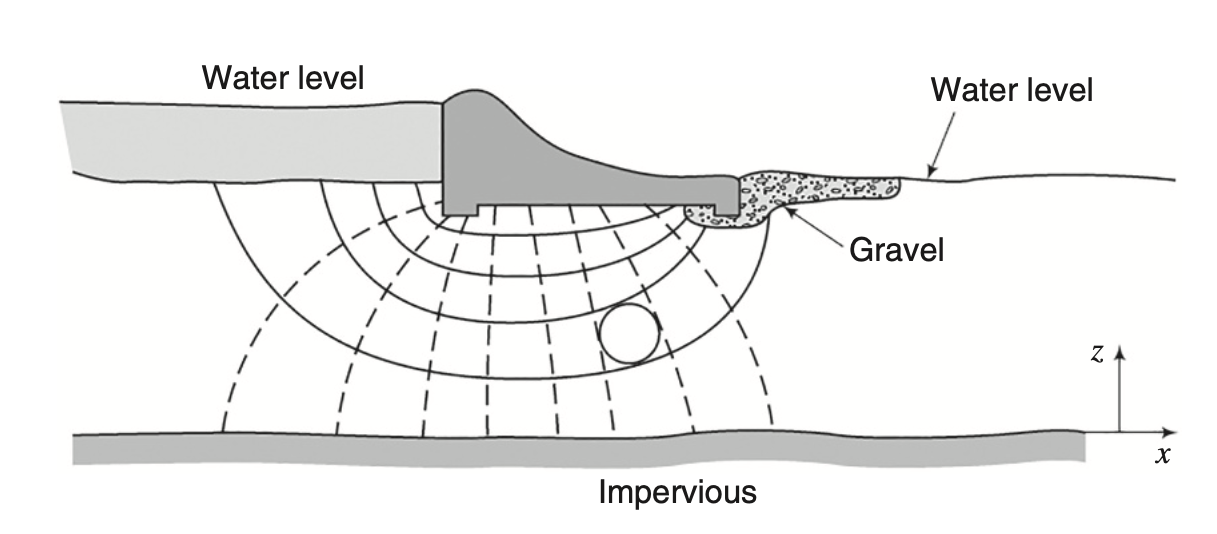
Practical tip:
Start with boundary conditions from page before, then sketch equipotentials and streamlines iteratively until squares form.
The famous dam seepage problem
Classic problem: seepage under a dam
Boundary conditions:
- Left side: Constant head (upstream pool level)
- Right side: Constant head (downstream pool level)
- Bottom: No-flow boundary (impermeable bedrock)
- Top: Free surface or no-flow
Result: Curved flow paths that form approximate squares

Reading the Flow Net
What the flow net tells us:
- Flow direction: Follow the streamlines
- Head distribution: Read from equipotential values
- Flow concentration: Closer streamlines = higher velocity
- Seepage quantity: Can be calculated from the net
Engineering applications:
- Assess dam safety (uplift pressure)
- Design drainage systems
- Estimate seepage losses
Key insight:
Maximum head gradient (steepest flow) occurs where equipotentials are closest together.
Quantifying flow
Let’s consider the 1 dimensional example
For a single flow channel between two streamlines: consider the 1d Darcy equation
Where:
\Delta Q = flow through one channelT = transmissivity\Delta h = head drop between equipotentials\Delta W / \Delta L = width/length ratio (≈ 1 for squares)
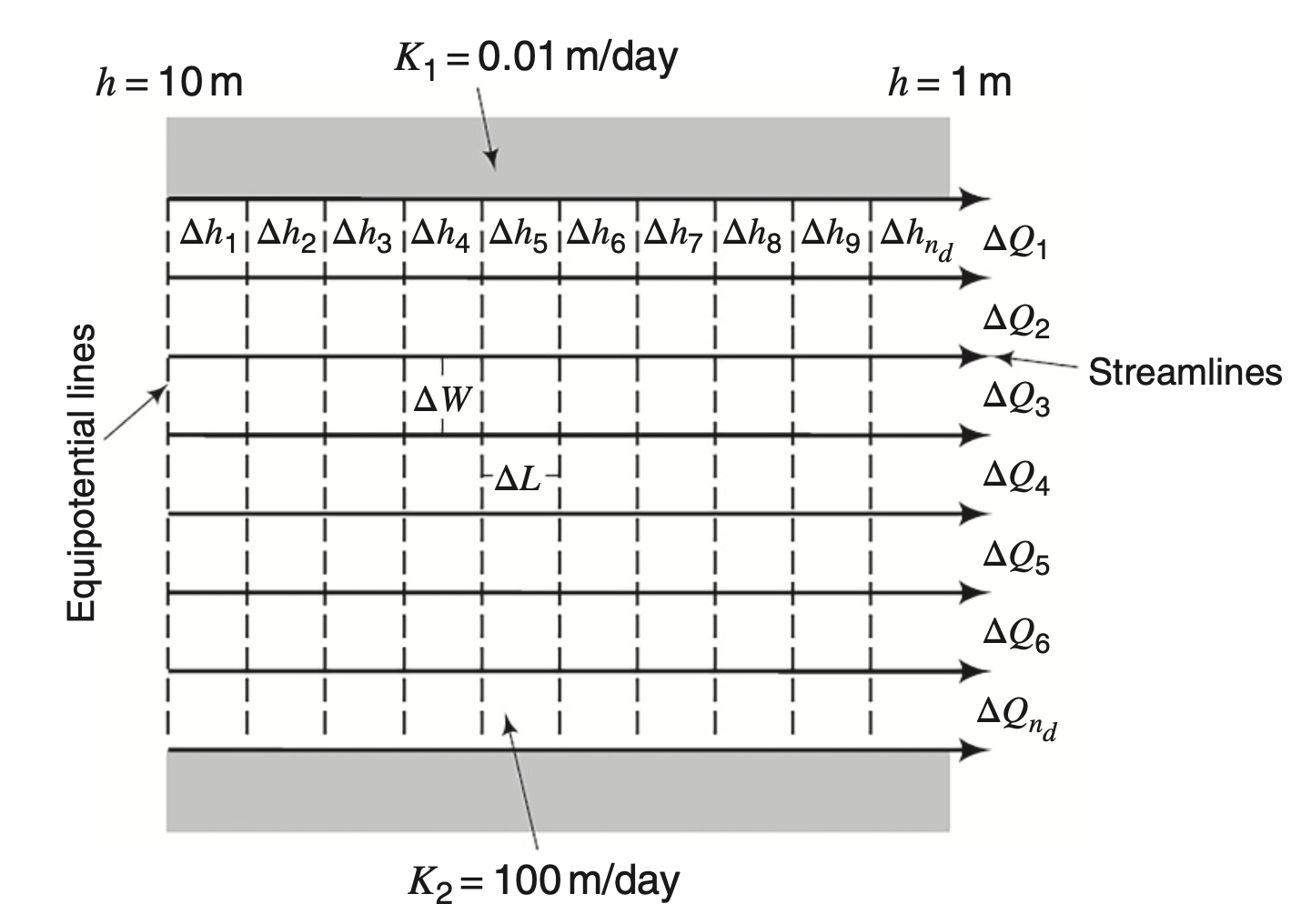
Another way of looking at it
Let’s say there are a total number of
then the flow rate is equal to
Where:
\Delta Q = flow through one channelT = transmissivity\Delta h = head drop between equipotentials\Delta W / \Delta L = width/length ratio (≈ 1 for squares)

Total Flow Calculation
For the entire flow system:
Where:
n_f = number of flow channels (between streamlines)n_d = number of equipotential drops\Delta H = total head difference across system
Practical steps:
- Count flow channels
- Count equipotential intervals
- Measure total head drop
- Apply formula
What we learned
We explored the theoretical foundations of groundwater flow, covering:
- Mathematical Framework: recognizing differential equations and their characteristics (dimensionality, steady-state vs transient)
- Equation Derivation: conservation of mass in a representative elementary volume leading to the groundwater flow equation
- Darcy’s Law Integration: combining flow relationships with conservation principles
- Specialized Cases: steady-state flow, isotropic media (Laplace’s equation), and unconfined aquifers (Boussinesq equation)
- Boundary Conditions: Dirichlet (specified head), Neumann (specified flux), and Cauchy (head-dependent flux) boundaries
- Initial Conditions: starting points for transient problems and their physical significance
- Flow Net Analysis: visual representation of flow patterns using streamlines and equipotentials
- Practical Applications: dam seepage, flow quantification, and engineering design using flow nets